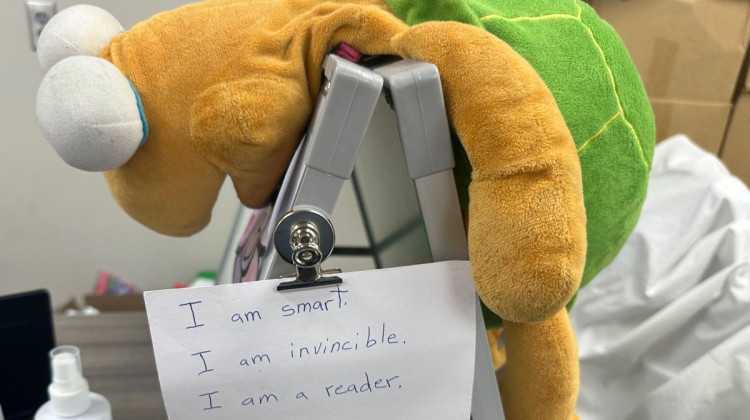
Indiana University's initiatives include hiring 25 more faculty, creating new degree paths, building up laboratory space and creating the Center for Reliable and Trusted Electronics.
Courtesy of Indiana University IT Communications OfficeIndiana University announced a major investment in one of Indiana’s emerging industries: microelectronics.
IU will invest at least $111 million over the next several years in microelectronics and nanotechnology, according to a university press release. The investments will be spread across new and existing initiatives, such as recruitment of 25 new faculty, new degree programs and the launch of the Center for Reliable and Trusted Electronics.
Naval Surface Warfare Center, Crane Division, is a partner in the investment, and funds will also go toward addressing national security challenges.
These investments show IU is thinking large-scale, said Daniel Loveless, associate professor of intelligent systems engineering.
“How do we build not just a new research capability but a pipeline of expertise in microelectronics, building relationships with our community that are long term and sustainable,” Loveless said. “It's lining this up with many other initiatives that have been ongoing for the last couple of years and that will be emerging over the next couple of years.”
Why are microelectronics and semiconductors a big deal?
Every computing system uses microelectronics like semiconductors — cell phones, TVs, laptops, spacecraft — to store information, Loveless said. Semiconductors were invented in the 1960s and have rapidly evolved since then. Over the last decade, they have become smaller, use more energy and are more expensive.
Semiconductors make everyday tasks possible, and the workforce for this vital technology was not being retained in the U.S., he said.
“The number of facilities worldwide that can manufacture the most state-of-the art microelectronics technologies is diminishing,” Loveless said. “Right now, there are really only three or four manufacturing facilities in the world that can fabricate the most advanced technology. And none of those are in the United States.”
This problem was made worse by shortages during the COVID-19 pandemic.
Every entity — private citizens, the government, spacecraft manufacturers, commercial businesses, the military — uses the same microelectronics. When there are shortages or a lack of control over the manufacturing, there are security concerns, Loveless said.
“It's how we communicate with one another. It's how we store our secure information, or personal information,” Loveless said. “And the less control we kind of have over that the more risk there is.”
IU joins federal and state investors in microelectronics
President Biden signed the bipartisan CHIPS and Science Act of 2022 into law to fund emerging technologies and keep America’s economy competitive. The act puts more than $200 billion into the research and manufacturing of semiconductors.
The U.S. Department of Defense named Indiana a regional hub for research, development and production of microelectronics. The hub, called The Silicon Crossroads Microelectronics Commons Hub and led by Applied Research Institute, received $32.93 million in September in the first round of CHIPS funding.
Purdue University has also invested in semiconductors, including a semiconductor degrees program, at least $49 million for new nanotechnology facilities and tools, and a permanent presence alongside Crane in Odon.
Loveless said that as the U.S. and Indiana invest in manufacturing, the workforce needs to build up at all levels.
“There's research and development funding, manufacturing funding,” he said. “ And really to try to encourage people to stay in the field and continue these growth opportunities.”
IU plans wide range of investments with Crane partnership
Naval Surface Warfare Center, Crane Division, is a partner in the investment, and funds will also go toward national security challenges. Angela D. Lewis, technical director of NSWC Crane, said in the release Crane is “appreciative of commitments” like IU’s investment.
“As our nation continues to confront new and emerging defense challenges, strengthening our research capabilities, advancing innovative new technologies and developing a highly trained workforce will be critical to the future of U.S. security,” Lewis said.
One project, the Center for Reliable and Trusted Electronics, was created with $10 million from IU, a $5 million grant from Crane and another $1 million from the Indiana Economic Development Corp., according to the release.
Loveless said this center will have “niche” research ability and innovation, making microelectronics that can withstand extreme environments or for longer timelines.
He said, for example, these microelectronics would be useful for a spacecraft that needs to function for years. The technology would need to work in a vacuum that can get very hot or very cold, and still function in situations with a lot of radiation.
“Our intent is to be sort of a niche provider of the information required for these high-reliability, maybe high-risk avenues of microelectronics use, because we see this as a core requirement to future systems that are enabling our national infrastructure,” Loveless said.
IU will also allocate $53.5 million for laboratories and other facilities, equipment and faculty start-up costs. This goes alongside IU Bloomington’s Faculty 100 hiring initiative, which will add 25 faculty in microelectronics and other emerging fields in tech.
Three new degree programs in microelectronics and nanofabrication will be offered through the Luddy School of Informatics, Computing and Engineering. This will cost $13.5 million.
He said IU will have facilities and testing capabilities not available anywhere else in the world.
Workforce development is key to the “pipeline of expertise,” Loveless said. He said getting young people involved early in research is vital.
“We have undergraduate students participating in spacecraft missions, we have outreach initiatives with high school students and middle school students,” he said. “We have funding opportunities for young students to come to campus and engage in research initiatives and projects we have partnerships with companies to hire our students as interns.”
IU will collaborate with Purdue and Notre Dame, he said, with the Indiana Research Consortium. IU seniors have already worked with NASA or the Department of Defense as part of the new workforce initiatives.
Microelectronics have evolved faster than anything humans have created, Loveless said, so it’s important for IU and educators to prepare students to work with technology that might be completely different by the end of their degree.
“We have to be nimble not only in our research, but in our educational philosophies,” Loveless said. “So we're trying to craft degree pathways that can kind of embody some of this nimble nature of these technologies.”
 DONATE
DONATE






 Support WFYI. We can't do it without you.
Support WFYI. We can't do it without you.